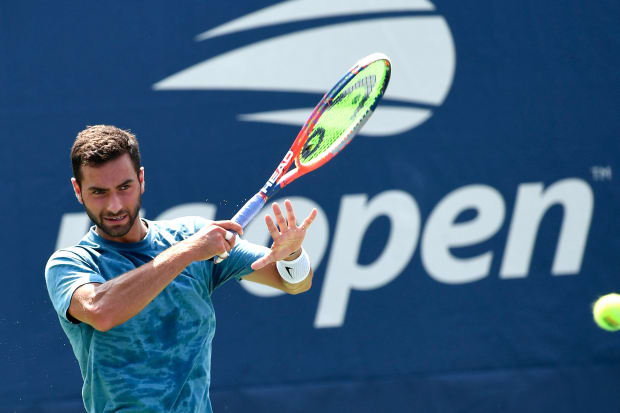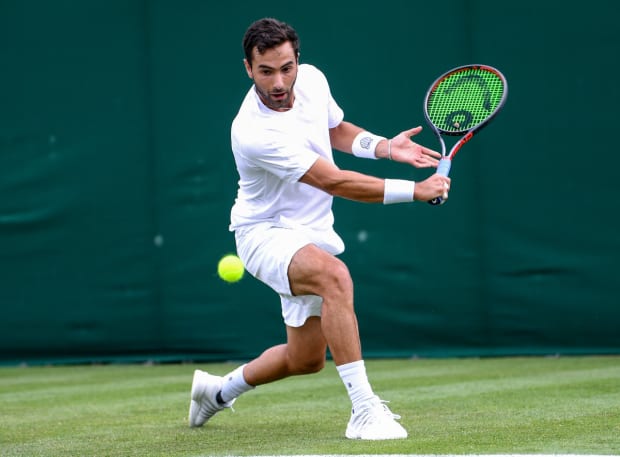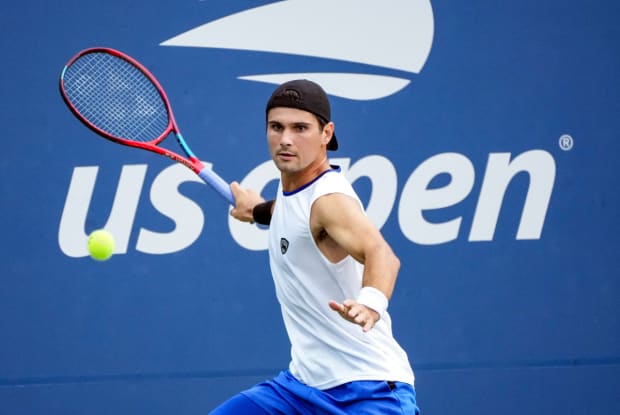Noah Rubin and Marcos Giron have both played in the main draw of every major, but breaking even as tennis professionals hasn’t been a given for either. They’re not alone.
Noah Rubin trained his entire life to be a professional tennis player. Literally. He started playing as a 1-year-old. His parents bought a junior racket before Rubin was born and invested hundreds of thousands of dollars in their son, who trained throughout his adolescence at the John McEnroe Tennis Academy in New York.
But seven years after turning pro and on the heels of a pandemic, Rubin has come to terms with what thousands of other players hoping to make a career out of the sport have realized: “If you’re playing tennis to make a living,” he says, “you’re playing the wrong sport.”
Since making the leap to the pros in 2015, sustained success at the next level has been hard to find for the 26-year-old. Years of toiling at the lower levels of the tour, dealing with injury setbacks and failing to make a breakthrough at a big event have worn him down.
Long days on the road, yearly expenses in the six-figure range and nonstop training all for prize money that barely makes the journey profitable makes tennis a sport with an incredibly high barrier to entry and even higher walls guarding a life of wealth and fame. There are usually no stadium courts or complimentary cars or luxe accommodations. Tennis, most of the time, looks nothing like the U.S. Open.
But Rubin isn’t O.K. with that, for himself or others. He wants to “beat the system” and create a better game for future generations. How? Well, as is often the case, at the center of the discussion is money.

Sarah Stier/Getty Images
In 2014, Rubin defeated current world No. 12 Taylor Fritz en route to the Wimbledon boys singles title, ending a seven-year American drought at the competition. That year, he also won the USTA junior national championship titles in both singles and doubles before a freshman season at Wake Forest that saw him come within points of winning the NCAA singles championship.
After seeing his fellow American in Fritz go straight to the pros and start climbing the rankings fairly quickly, Rubin, then 19, felt the time was right to make the leap himself.
And things got off to a pretty good start: He received a wildcard invitation to the 2016 Australian Open, made it to the second round and was moving up about a 100 spots in the rankings each month in his first year out of school. At the ’17 Australian Open, Rubin played against Roger Federer in Rod Laver Arena, the tournament’s biggest stage.
“Here I am at basically 19, 20 years old and I just got a $65,000 check,” Rubin says. “You get a $65,000 check in one week, you know, things are looking up. You're not really questioning aspects of living expenses. I go out and buy a pair of Ferragamo shoes because why not?”
Then, three months later at an ATP event in Houston, Rubin broke the scaphoid bone in his wrist after slipping on the clay surface. “That’s when I realized there are definitely some issues within this sport that are going to be tough to overcome,” Rubin says. Suddenly the money wasn’t coming in, his ranking dipped back into the 200s, and the shopping trips transformed into stretches of anxiety.
Rubin would eventually reach his career high of No. 125 in the rankings in October 2018, but he’s hovered around No. 200 for most of his career—not high enough, he estimates, to even make it into the black.
“If you’re doing it correctly, at No. 150 in the world you’re probably breaking even or maybe making a little bit of money, so that’s not a living,” Rubin says. “If we’re talking about making a true, solid living in tennis, I’d say [you need to reach] 75th in the world.”
Despite various injuries over the past five years, Rubin kept his career alive by making six main draws (and cashing six relatively big checks) at the majors and playing qualifying rounds in 12 others. A little over half of his listed $807,765 career earnings have come from those 18 tournaments, which serve as financial lifelines and stressful make-or-break events for those on the fringes of the sport. The Grand Slam events are by far the most significant revenue source for players who otherwise might earn as little as a few hundred dollars for losing early in an ATP Challenger or ITF-level tournament. But it is nearly impossible to plan your life around four unguaranteed, variable-sized paychecks.
“The budgeting is off to begin with in many aspects,” Rubin says. “The sport as a whole is just not receiving enough revenue to make it worthwhile for everybody involved, and then the players lose out.”
Even at his career high, Rubin says he used to joke that he didn’t make any money, which is about true once costs are factored in. If a player is worried about expenses and trying to save wherever he can—staying at cheaper hotels, adding a leg to a flight to save a few thousand dollars—keeping the tour life going costs, at minimum, $35,000 to $45,000 a year for each person the player travels with, Rubin says, including the player. An additional coach or physio also requires a salary and per diem that the player must provide, which adds another $9,600 to $30,000 a year.
So for a player who travels with a coach and a physio as part of his team, let alone even more, that player could be spending $250,000 or more to do so each year.
“[Being] No. 120 in the world and pocketing $40k, $50k at the end of that year is depressing,” Rubin says. “There’s really no other words to kind of describe that.”
Typical sponsorships don’t provide much relief, either. Unless a player is part of the “next gen,” like 19-year-old Spanish sensation Carlos Alcaraz, or is one of the elite faces on tour already, the cash just isn’t there from businesses, Rubin says.
There are individuals or groups of people who help sponsor players during their careers. Some do it because they have a previous relationship with the player. Some treat it more as an investment so they can make money off the player down the road, and some just do it out of the kindness of their hearts.
“I’ve been a part of it, and I luckily have one today,” Rubin says. “It’s a business transaction. Whether it’s credentials, tickets, lessons or whatever else it may be, because money is just not coming from businesses.”
While Rubin stresses that, yes, it is possible to make a living out of playing professional tennis, the reality is that for every Fritz or Alcaraz, there are thousands of other young players coming up the junior ranks, the USTA development system or playing in college who will likely never reach the No. 150 threshold that would make a sustainable career even remotely feasible. It’s why he doesn’t sugarcoat the harsh realities of the sport anymore when giving advice to younger players.
“If you really want to do this and take it on, make sure you’re okay with losing about $30,00 to 40,000 a year,” Rubin says. “Don’t expect yourself to make any money or gain any serious ATP points and move forward in the rankings. People come in with these preconceived notions of ‘I’m gonna get to No. 150 in the world in a year or two,’ and very few people ever get there.”

Laurence Griffiths/Getty Images
Twenty-eight-year-old American Marcos Giron needed five years to reach the 150 mark. Since 2018–when he was as high as No. 447–Giron has steadily climbed the rankings to his current spot at No. 56.
The Californian turned pro in 2014 after a junior season at UCLA that saw him win the NCAA singles championship, but it took him eight years to get to a point where he could make a schedule composed fully of ATP Tour events (as opposed to the lower ATP Challenger and ITF tours).
Soon after Giron made the leap to the professional ranks, hip problems began to flare up. And though he tried to play through the injuries, eventually the pain became unmanageable. The eventual result was two hip labrum surgeries, the first on his right hip in December 2015 and the second on his left in February ’16. At that point, Giron was in the upper 400s of the rankings after failing to make much progress since leaving school. Being on the road for 20–30 weeks out of the year and coordinating the necessary logistics like racket stringing and coaching, all of which were provided by UCLA in college—posed new challenges that compounded to make life in the pros difficult.
“You just don’t know what it’s like to travel until you do it,” Giron says. “People can tell you it’s going to be a lot, but there’s nothing that prepares you except for really experiencing it.”
Knowing he now had no choice but to take a nine-month rehab break, Giron reached out to Billy Martin, his college coach at UCLA, and asked whether he could come back to school to help the team. Martin obliged, and from January to May that year, Giron served as UCLA’s second assistant coach on a volunteer basis.
Giron’s time away from the daily pressures of being a fledgling professional player gave him a new perspective that helped him attack his career after returning from his injuries in September 2016.
In his first 17 months as a pro before the first hip surgery in 2015, Giron earned $68,731 in prize money. Half of that came from one match: his wild-card appearance in the ’14 U.S. Open—a berth he earned by winning the NCAA singles title—in which he lost in the opening round to John Isner.
In 2019, with his hips quiet and his understanding of the tour’s demands more developed, the wins started coming. Giron began the year ranked No. 308 and climbed more than 200 spots to finish it at No. 102. He cracked the top 100 in August ’20 and since then has kept climbing to his current ranking just outside of the top 50. Between ’19 and ’21, Giron amassed $1.47 million in prize money.
“Once you start doing better, you actually get a little more money, which then takes a little bit of financial pressure off, and you can travel with less worry and stress,” Giron says.
It’s been a long road for Giron, but he’s still two years away from 30, and he feels like he now knows how to stay afloat, if not strike it rich. “I know that there’s so many guys who have broken the top 100 and that have immediately dropped out and never made it back,” Giron says. “Yeah, it took a while, but it also makes me not take these moments for granted. I want to maximize every opportunity that I have. Each opportunity you have could be the last opportunity to make the most of it.”
Giron’s story, though, is not normal.

Jerry Lai/USA TODAY Sports
During his pause from the tour amid rehab and recovery, Giron rekindled his love for the game. Rubin loves the sport, too. Away from the money and the sponsorships, he just appreciates how beautiful a game it is. But Tennis the Job wasn’t loving him back. So when Rubin’s career, and the rest of the tennis world, paused in 2020 with the arrival of the COVID-19 pandemic, an opportunity arose for him to think about what would be next.
The pandemic put a magnifying glass on everything Rubin felt was wrong within the sport: the constant travel, the convoluted ranking system, the year-round schedule. Suddenly everyone was at home on their couches, and an opportunity presented itself for tennis to rethink the way it conducts itself. In his view, the sport was completely reactive rather than proactive about the situation, and Rubin decided he’d had enough.
“We couldn’t utilize that time to actually experiment and try new things out and evolve,” Rubin says. “It was completely embarrassing, and that was when I called tennis a lost cause.”
He had already started Behind the Racquet in early 2019, a website and Instagram page featuring first-person essays from tennis players that highlight the realities of life on the road, financial anxieties and mental health struggles they face, and Rubin decided to shift more of his focus there. He’s become an advocate within the sport, hoping to inspire changes in how players are treated and suggesting structural tweaks to make the sport more digestible and appealing to fans to build a more sustainable game.
“Tennis is hindering the situation further to a point where it’s actually scary. Most of these players have depression and anxiety,” Rubin says. “ and it’s just because of how demanding the sport is, and how little it gives you back.”
Eventually, though, Rubin’s love of the game began to tug on him during his mid-20s semi-retirement. He’s still curious to see how far this sport that he’s been groomed to play his whole life can take him. Ultimately, Rubin needed a little bit more of the game in his life before he could give it up completely.
Since getting back on the court, Rubin has played a mixture of mostly Challenger and ITF tour events with a few ATP 250s mixed in over the past two years. Because of the time off, his ranking has fallen into the 500s, but the blinders are off now. He understands what it means to be a professional tennis player in a way that he didn’t earlier in his career.
“I’m less naive than I’ve ever been,” Rubin says. “I understand what I have to do if I want to get to that point and how difficult it's going to be, but it takes some time.”
But Rubin isn’t putting all his eggs in one basket. He knows tennis isn’t built to work for him, or most people. “The rich always get richer. That’s just how it works.” But his lifelong tennis goals remain. Maybe he can eventually become a top-50 player and make a solid living, at least for a little while. And if he can’t, well, at least now he has a better understanding of what’s possible.
“Tennis is really the only place where I feel myself,” Rubin says. “I need that competition as much as I hate everything that goes into it at times. When I’m in a tough three- or five-set match, that’s kind of where I shine, and that’s where I feel alive, as cheesy as it sounds. So I needed a little bit more of that in my life before I gave it up.”
More Tennis Coverage: